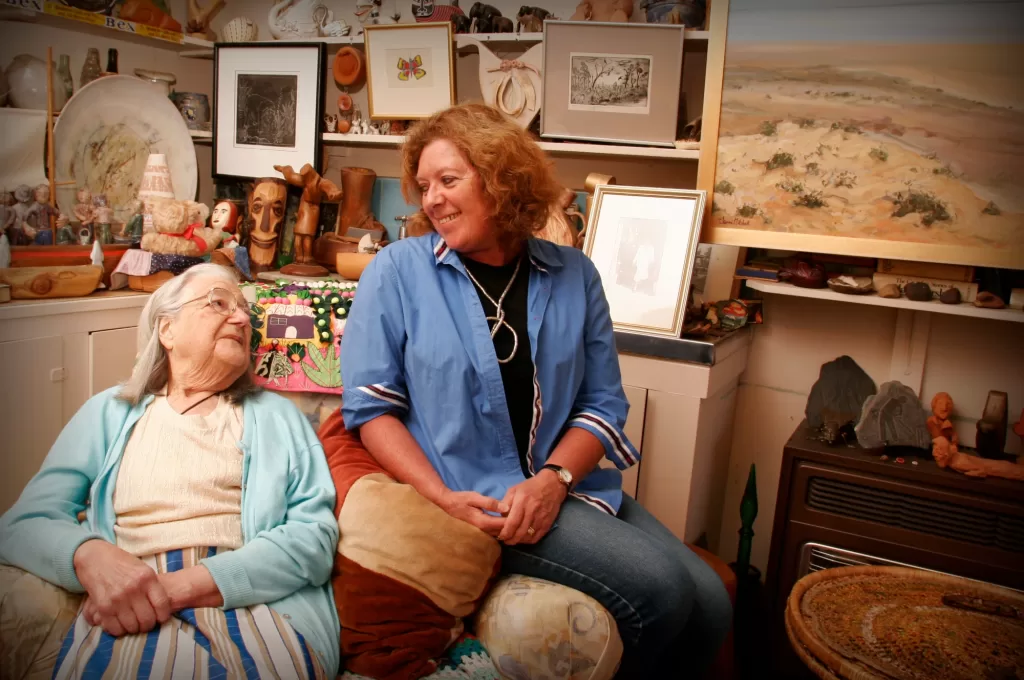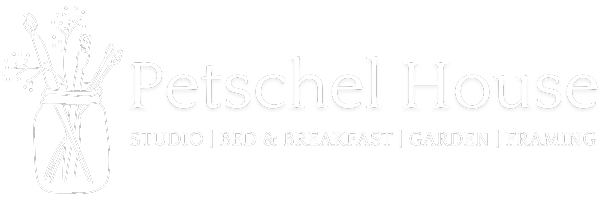Grace Mitchell 1916 – 2011
by Jenni Mitchell

Grace Mitchell was born in Yarram, Gippsland Victoria in 1916, the second eldest of nine children. Her first memories were of a happy family life, walking the three miles to school at the tiny town of Hiawatha; and sometimes if lucky, riding the family pony. She spoke of the wild flowers picked along the way the place where large crystal shards grew from quartz rock under a bridge.
When Grace was eight years of age her father came home from a wood chopping competition at the local fair and dropped dead in the back yard. This changed everything. Grace’s mother, with seven young children then moved from Gippsland to Creswick. At age 12 Grace left school for work to help support the family. She had myriad occupations during her long life; working by day and studying at night. She was a tailor, dressmaker and a cook. She studied psychology and journalism and worked as a matron at the School of Mines in Creswick. Her fine crotchet patterns were published in women’s magazines when she was thirteen and her writings published soon after.
When Grace came to Melbourne to work at the Royal Melbourne Hospital as a dietician and lived in a rooming house in St. Kilda overlooking the George Hotel. She would often speak of the antics going on in the hotel across the way with amusement.
Grace came to live in Eltham with her husband Arthur in 1948 and settled into a little old miners cottage on Mt. Pleasant Road. This property was bought for the enormous price of two hundred and fifty pounds. The property extends between Mt. Pleasant and Fordhams Road.
Grace and Arthur established an orchard and vegetable garden with fruit trees that included several varieties of apple, pear, cherry, peach, plum, apricot, lemon and almond. They raised chooks and kept bees. On this small property they produced all of their daily needs as learnt from the country farms they had both be raised.
Arthur had been a Life Assurance Inspector working with Colonial Mutual Life Assurance Society Limited and spent much time selling insurance around the Western District of Victoria. Soon after their marriage he had an awful accident that caused a head injury and he was incapacitated for many years. Grace once more took on the responsibility of working to support her family. She walked each morning into Eltham to work as a tailor at the Hitone factory. On her way home at the headmasters request she would call in and sweep the then tiny Dalton Street School. She tells of how awful it was to come home and find Arthur alone all day asking where she had been. He was unable to do much more at this time than to tend his garden and bees.
Needing to find a way to stay home and care for Arthur as well as earn an income Grace came upon the idea of starting the pastry shop. She had enough money saved to build the first two rooms and install an oven behind the counter.
Grace then had her first encounter with local government and bureaucracy. Objections were raised to her opening a pastry shop – and mostly from the milk bar across the road. After several council meetings and much letter writing she was granted a permit.
Grace was a fiercely independent person who was proud of the fact she built her shop and business with her own hands without ever borrowing a penny. She built each room when she had enough money saved to do so and never spent more than she had.
Today we revere as fashionable what Grace and Arthur did by nature. Their organic garden today is called permaculture. Their hens had large free runs, their droppings spread on the garden and long pits dug for composting all of the vegetable waste. Arthur would grow, dig, wash and mince the vegetables for the pasties while Grace hand made and rolled the pastry. They cooked and minced their own meat for the pies and the fruit for the sweet pies came also the orchard.
For sixteen years Grace continued growing her pastry shop business. She baked dozens of scones, cakes and pastries daily. For a while she also opened rooms to serve Devonshire teas – delicious scones and home made jam and tea and for a short while dinners on the weekends. The secret to her success was simply her hard work and dedication to quality ingredients. Travelling salesmen would offer to sell her packet mixes to bake her cakes and she always refused opting instead for mixing her batters by hand or with the aid of electric beaters. Boxes of butter and sacks of flour and sugar were delivered weekly and on the weekends she would sit up until 3.00am and rise again often at 6.00am to prepare for the coming day.
She became legendary across Melbourne and a destination for weekenders taking the train to Eltham and walk for an afternoon tea. Among her most notable regular customers was Sir Robert Helpmann who brought as his guest one weekend Katherine Hepburn. Local Eltham artisans’ and academics also bought pastries along with their weekly groceries; milk, eggs and cigarettes. When the garden produced extra vegetables and fruits they too were for sale.
Grace had a talent for cake decorating and always seemed to have a two or three tier wedding cake underway. The rich fruitcake was baked in the traditional manner using almond and royal icing and decorated with Grace’s hand made sugar flower sprays.
From apparently nowhere, in 1955 Grace gave birth to a little girl. Jennifer arrived three months after Grace had complained of feeling ill and the six-month pregnancy had been diagnosed! The ever-considerate Jennifer was nearly born in the taxi; shortly after the lunchtime crowd had been served.
Each year prior to Christmas the kitchen was buried deep under Christmas cake orders and plum puddings drying in their cotton clothes along the clothesline. The puddings were boiled up in the large wood fired copper pot outside. Customers were delighted with the sprinkling of silver threepences and sixpences, which made their cake stained way back to the shop in the hands of children wanting to buy sweets.
After sixteen years of seven day a week baking Grace retired exhausted. She had saved enough through her business to pursue her dream to set up a bed and breakfast by the sea around Eden. Then Arthur died and she did not managed to leave Eltham.
Instead, she enrolled in a short course of sculpture at the CAE. Then at age sixty-seven Grace enrolled and was accepted into Art School. Grace became Phillip Institute’s (RMIT) eldest student. It was an easy transition for Grace from textile work and sugar sculpture to clay sculpture, woodcarving and printmaking. She gained her car licence and found a new independence. She absolutely loved art school and the luxury of making art and studying just for the sheer joy of doing so just for herself. Grace enjoyed the history lectures, life drawing and working with clay, wood and the print room where she undertook etching, screen-printing and lithography. She made friends with the younger students and remained in contact with many for the rest of her life.
Grace never really retired; at Sigmund Jorgensen’s request she helped him out for what extended to seven years as head cook for Montsalvat. She prepared the feasts for the Saturday weddings and very often worked extra days when needed during the week.
Sigmund would bring the fresh produce from the markets and Grace arrived early in the morning to cook the roast meats and her prepare her famous chocolate mouse.
Her days at Montsalvat came to end after what should have been e a minor medical procedure became a nine-day intensive care battle for life. This was not the only time. Perhaps knowing she survived breast cancer in her 20’s may inspire others; she went on living into her 95th year.
Grace’s house was of the artwork produced during her later years. Reluctant to part with any for money stating instead the work was made for the love of making and not the need to work she treasured. In art history language she would be classified as a true naïve or primitive artist as she did not follow a particular fashion and did just as she pleased. Grace was not interested in fashion art or what the latest magazines dictated or what people would say or buy. She enjoyed studying the work of other sculptors and artists and appreciated both traditional classical and contemporary work. She would more likely make a work as a commission rather than part with one of her own pieces.
Grace was at peace in the garden equally as at her workbench or sitting with an embroidery. She could stick a piece of bark in the ground and it would grow – her green thumb was extraordinary. She loved to experiment with strange gardening concoctions producing organic compost that sometimes wished she wouldn’t. By example – a pot of fallen fruit mixed with nettles and weeds left to ferment in water for some weeks would produce a vile liquid capable of restoring a rusted tool close to its original metal condition. Her cupboards contained both fine bolts of silk along with chisels, mallets and electrical sanders. Grace did not mind getting her hands dirty.
After Arthur died Grace took over robbing the bees and taught a course in bee keeping at the Eltham Living and Centre. She took pride in producing her own honey along with jams and marmalades from her garden.
Eighteen months after her death we have continued her legacy to use her house space as a gallery and her studio to teach painting classes. Grace is still everywhere. Her work lives on in the gallery and the orchard planted by both Grace and Arthur are still producing and those that been removed since replaced.
Grace always welcomed visitors to come and see her work. For Grace this was more satisfying than sending her treasured sculptures off to a gallery to be sold. At home she could both enjoy and share them.
We will be also sharing her work through the gallery and offering for the first time some of her works for sale and for the first time allowing others to own her pieces and start their own journey.
Days before she died Grace presented one of her major pieces to the Nillumbik Shire Council. Her beautiful hand embroidered silk shawl will be on permanent exhibition in the Eltham Library. Nillumbik Shire has kindly offered to loan the shawl to the gallery for the exhibition.


